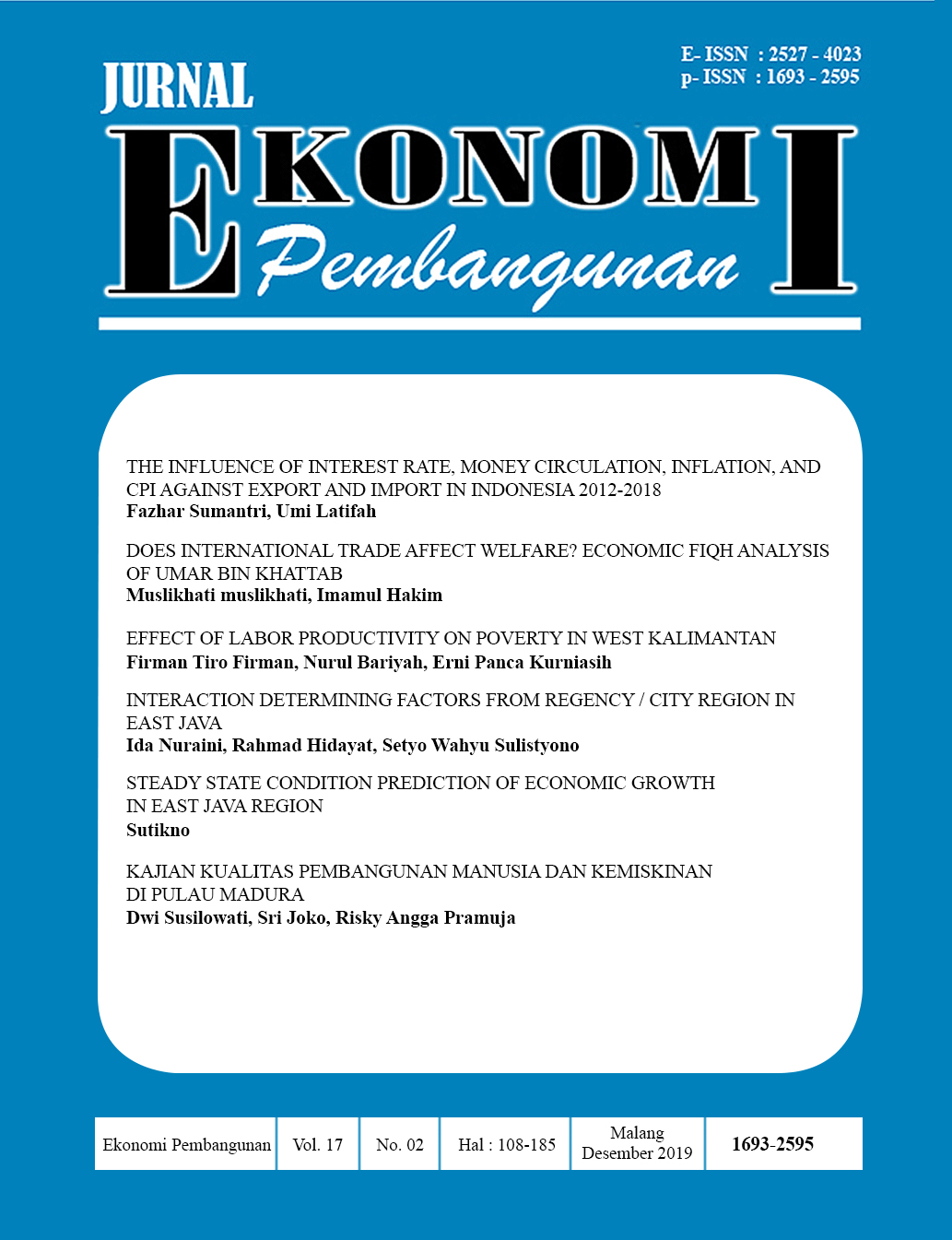STEADY STATE CONDITION PREDICTION OF ECONOMIC GROWTH IN EAST JAVA REGION
DOI:
https://doi.org/10.22219/jep.v17i2.11063Keywords:
Economic growth, Inequality, PlanningAbstract
The quality of development of a country or region is not only seen from the high level of economic growth, but also the higher level of economic growth produced by people in a country or region. One of the economic development debates in East Java in the last few decades is the imbalance of development between regions. This article focuses its analysis on the value of "stable conditions" districts / cities in East Java in reducing income disparity between regions. The analysis in this study is a convergence analysis conducted in East Java Province using a conditional convergence test with observations of all districts and cities in East Java. Variable interest is income per capita. Variable gross fixed investment, net exports, labor force, capital expenditure, human development index. The success variable is the average economic growth in 2010-2018. Whereas the theory underlying all these variables is the Solow-Swan classical economic growth model. The convergence speed results explain the convergence speed in East Java Province by 4.8 percent. Regarding income per capita in developing countries which must grow at least 4.8 percent per year for the Java economy to reach a stable point. The amount of time needed to cover half of the initial period (half-life of convergence) is 6.2 years
Downloads
References
Andrian Syah Malik, (2014). Analisis Konvergensi Antar Provinsi Di Indonesia Setelah Pelaksanaan Otonomi Daerah Tahun 2001-2012. JEJAK: Journal of Economics and Policy, Jejak 7 (1) (2014): 92-101. DOI: 10.15294/jejak.v7i1.3846.
Abramovitz, Moses. (1986). Catching Up, Forging Ahead, and Falling Behind. Journal of Economic History June 1986 pp. 385-405.
Badan Pusat Statistik Provinsi Jawa Timur. (2019). Tingkat Ketimpangan Pengeluaran Penduduk Provinsi Jawa Timur Maret 2019. No.46/07/35/Thn.XVII, 15 Juli 2019. Surabaya.
Badan Pusat Statistik Provinsi Jawa Timur. (2018). Provinsi Jawa Timur Dalam Angka 2018. No. Publikasi/Publication Number: 35560.1803. Surabaya.
Barro, R.J. dan X. Sala-i-Martin, (1992), “Convergence”, Journal of Political Economy, 100(2), April: 223-51.
Barro, R.J. and Sala-i-Martin, X. (2004) Economic Growth. 2nd Edition, MIT, Cambridge
Beritajatim.com. (2019). Gubernur: Pemprov Jatim Lakukan 3 Intervensi Atasi Kemiskinan dan Kesenjangan Ekonomi. 15 April 2019. From: https://beritajatim.com/peristiwa/gubernur-pemprov-jatim-lakukan-3-intervensi-atasi-kemiskinan-dan-kesenjangan-ekonomi/
Capello, Roberta. (2007). Regional Economics, Routledge.New York, Routledge.
Gujarati, Damodar N., dan Dawn C. Porter. (2010). Dasar Dasar Ekonometrika. Buku 1. Terjemahan Eugenia Mardanugraha dkk. Jakarta: Salemba Empat.
Kementrian Keuangan RI. (2012). Tinjauan Ekonomi dan Keuangan Daerah. Jakarta: Kementrian Kuangan RI.
Kementrian Keuangan RI. (2019). Tinjauan Ekonomidan Keuangan Daerah. Jakarta: Kementrian Kuangan RI.
Kharisma, B., & Saleh, S. (2013). Convergence of Income Among Province in Indonesia 1984 - 2008: A Panel Data Approach. Journal of Indonesian Economy and Business, 28 (2), 167- 187.
Kuncoro. 2013. “Mudah Memahami dan menganalisis Indikator ekonomi”. Yogyakarta: UPP STIM YKPN.
Lall, S. dan S. Yilmaz, (2001), “Regional Economic Convergence: Do Policy Instruments Make a Difference?”, Annals of Regional Science, 35(1), Februari: 153-55.
Mankiw, N. Gregory. (2003). Teori Makroekonomi (p.23). Edisi Kelima. Terjemahan Imam Nurmawan. Jakarta: Erlangga.
Mohtar Rasyid. (2017). Konvergensi Pendapatan Provinsi Jawa Timur: Pendekatan Panel Kota/Kabupaten Periode 20002013. Jurnal Ekonomi Kuantitatif Terapan Vol. 10 No. 2 Agustus 2017.
Prasasti, Diah. (2006). Perkembangan Produk Domestik Regional Bruto Per Kapita 30 Provinsi di Indonesia Periode 1993 – 2003: Pendekatan Kesenjangan Regional dan Konvergensi. Jurnal Ekonomi Bisnis Indonesia vol 21 No 6 Hal 364360.
Riatu, Q., (2002), “The Analysis of the Effect of Intergovernmental Transfer on Regional Economic Performance”, Working Paper, International Studies Program, Andrew Young School of Policy Studies, Georgia University, http://www.isp-aysps. gsu.edu/papers/indonesia/riatu.pdf.
Shioji, Etsuro. (2001). Public Capital and Economic Growth: A Convergence Approach. Journal of Economic Growth, 6, 205-227. Netherlands. Kluwer Academic.
Verawati Fajrin, Heri S. (2019). Analisis Pertumbuhan Ekonomi Di Pulau Madura. Jurnal Ilmu Ekonomi-Qu. Volume. 9, No. 1, April 2019.
Wibisono, Yusuf. (2001). Determinan Pertumbuhan Ekonomi Regional: Studi Empiris Antar Propinsi Di Indonesia. Jurnal Ekonomi dan Pembangunan Indonesia. Vol. 1. No.2. Januari.
Downloads
Published
Issue
Section
License
Authors who publish with Jurnal Ekonomi Pembangunan (JEP) agree to the following terms:
- For all articles published in Jurnal Ekonomi Pembangunan (JEP), copyright is retained by the authors. Authors permit the publisher to announce the work with conditions. When the manuscript is accepted for publication, the authors agree to the publishing right's automatic transfer to the publisher.
- Authors retain copyright and grant the journal right of first publication with the work simultaneously licensed under a Creative Commons Attribution-NonCommercial-ShareAlike 4.0 International License that allows others to share the work with an acknowledgment of the work's authorship and initial publication in this journal.
- Authors can enter into separate, additional contractual arrangements for the non-exclusive distribution of the journal's published version of the work (e.g., post it to an institutional repository or publish it in a book), with an acknowledgment of its initial publication in this journal.
- Authors are permitted and encouraged to post their work online (e.g., in institutional repositories or on their website) before and during the submission process, as it can lead to productive exchanges and earlier and greater citation of published work (See The Effect of Open Access).

This work is licensed under a Creative Commons Attribution-NonCommercial-ShareAlike 4.0 International License.






















